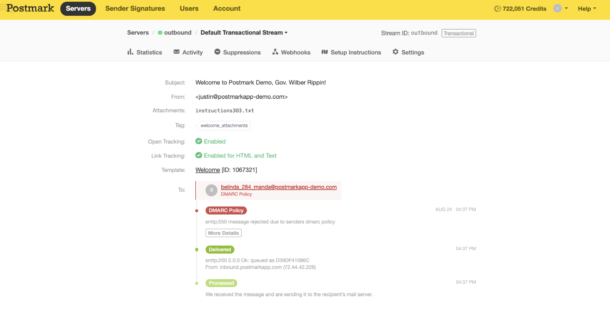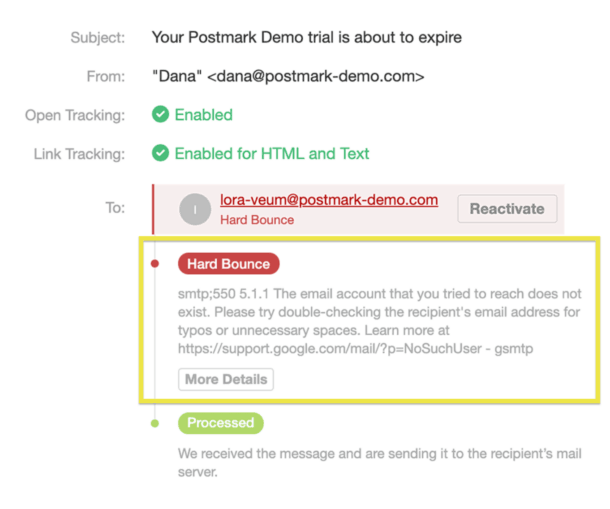Email deliverability is the ability to deliver an email to a recipient’s inbox in a timely manner. The better a provider’s deliverability, the greater the chances that an email reaches the recipient’s inbox instead of their spam or junk folders.
Why is email deliverability important?
#
If you are sending emails as part of running your business, deliverability is something you need to know about and monitor. Knowing about deliverability helps you avoid common-but-extremely-annoying situations, like forcing customers to frantically refresh their inbox waiting for a password reset or seeing your promotional email campaigns land straight into their spam folder and sit there forever ignored.


The difference between email deliverability and email delivery rate #
While email deliverability and email delivery rate might sound interchangeable, there is an important difference between them:
- Email delivery rate is the percentage of emails delivered to a receiving mail server (e.g. Gmail), regardless of where they go after that
- Deliverability focuses on inbox placement, and is the ability to quickly deliver an email to its final destination.
Think of it like this: imagine a marketer sends out 100 promotional fliers and gets 3 “return to sender” back. Delivery rate is the percentage of promotional fliers that are processed through the mail system; deliverability is how many of these actually end up in front of the recipients’ eyes.
Can our fictional marketer ever know if an individual recipient reads the flier, instead of seeing it as junk and tossing it in the trash? No, and neither can email providers: they know how many emails made it to a receiving server but have no visibility into what happens after. In other words: delivery rates are easy to measure, deliverability is sort of... impossible to.
(This is why, if a provider claims to have a specific deliverability score or percentage, they’re mis-using the term. Tut tut!)
How providers measure email delivery rate and email deliverability #
Email service providers (ESPs) can calculate their email delivery rate as a percentage: number of emails accepted / number of emails sent x 100. For example, if you send 5000 emails and 30 of them fail (e.g. bounce or timeout), the ESP’s delivery rate is 4970/5000 x 100 = 99.4%.
Unfortunately, individual providers can never put a specific number to their deliverability—but they can infer it by looking at their delivery rate, making sure they are adhering to the best practices for sending email, and monitoring customer complaints (more on this below).
Here at Postmark, for example, we have 99% delivery rates for both broadcast and transactional emails, and excellent deliverability for both. We also publish our email delivery time and update it every 5 minutes, because speed is a crucial component of deliverability.

How to know if you have an email deliverability problem #
Most email senders don’t know they have a deliverability issue until they start receiving complaints from customers who are not getting all the messages they should. Once they start investigating, they often find reputation-related bounces they didn’t know about or discover they’d been sending email from block-listed IPs.

💛 Friendly tip: unfortunately, some ESPs will actively try to hide these issues in their UI. Not cool! Having insight into a problem makes troubleshooting much easier, which is why we recommend that you look for a provider whose UI gives you clear, full details.
For example, let’s say you’re scratching your head over a customer complaining they didn’t receive an order confirmation. Within Postmark’s UI, you could find the email, click on “More Details,” and get the FULL non-delivery report from the receiver. That’s pretty much unheard of with any other provider!


How to ensure email deliverability #
A lot of factors contribute to deliverability, including:
Your domain reputation, or how your domain is perceived by mailbox providers.
Your IP reputation, which indicates how trustworthy your IP is. For example, a history of low spam complaints and bounce rates makes your sending IP more trustworthy than one with a high number of complaints.
The email content you’re sending: attaching files or using certain phrases or URLs in the body of your email may trigger a recipient’s spam filter and send your email straight into the spam folder.
The current status of the receiving infrastructure: for example, if Microsoft is having a problem with their mail servers and cannot accept mail, then everyone’s deliverability suffers—through no fault of their own.
The ‘little dance’ between sender and receiver that determines the amount and speed of emails that can be sent and received at any given time. Think of it this way: Gmail can accept a large number of messages at the same time, whereas a small business server wouldn’t be able to handle the same volume and probably shut down immediately. According to our Head of Deliverability, Anna, this is something not many people mention—but this constant negotiation about the speed at which mail can be given, the number of connections and IPs that are needed, the number of messages per connection, has a definite impact on deliverability.
To sum up: email deliverability is the sum of many parts and a lot goes into it. If you’re getting overwhelmed, we have a small present for you: take a 5-minute break and enjoy this webcomic we wrote to explain email deliverability.
We promise you’ll never look at your emails the same way again 😉




